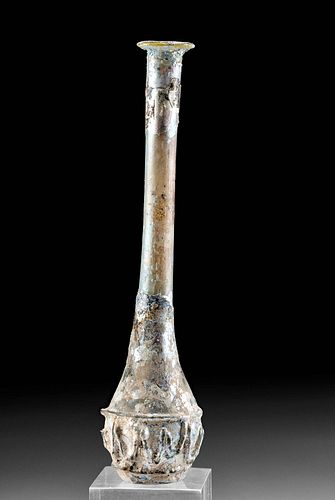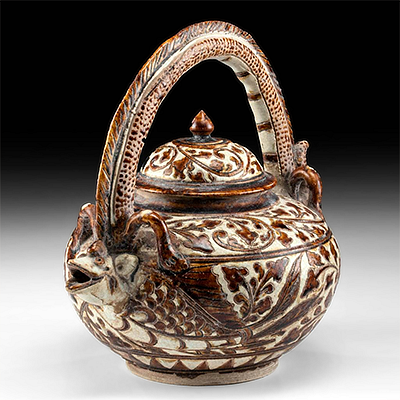Roman Glass Unguentarium w/ Trailing & Nice Iridescence
Lot 29
About Seller
Artemis Fine Arts
686 S Taylor Ave, Ste 106
Louisville, CO 80027
United States
Selling antiquities, ancient and ethnographic art online since 1993, Artemis Gallery specializes in Classical Antiquities (Egyptian, Greek, Roman, Near Eastern), Asian, Pre-Columbian, African / Tribal / Oceanographic art. Our extensive inventory includes pottery, stone, metal, wood, glass and textil...Read more
Categories
Estimate:
$600 - $900
Absentee vs Live bid
Two ways to bid:
- Leave a max absentee bid and the platform will bid on your behalf up to your maximum bid during the live auction.
- Bid live during the auction and your bids will be submitted real-time to the auctioneer.
Bid Increments
| Price | Bid Increment |
|---|---|
| $0 | $25 |
| $300 | $50 |
| $1,000 | $100 |
| $2,000 | $250 |
| $5,000 | $500 |
| $10,000 | $1,000 |
| $20,000 | $2,500 |
| $50,000 | $5,000 |
| $100,000 | $10,000 |
| $200,000 | $20,000 |
About Auction
By Artemis Fine Arts
Jul 1, 2021
Set Reminder
2021-07-01 10:00:00
2021-07-01 10:00:00
America/New_York
Bidsquare
Bidsquare : Antiquities | Asian | Ethnographic Art
https://www.bidsquare.com/auctions/artemis-gallery/antiquities-asian-ethnographic-art-7148
Featuring classical antiquities, ancient and ethnographic art from cultures encompassing the globe. Egyptian, Greek, Roman, Near Eastern, Asian, Pre-Columbian, Native American, African / Tribal, Oceanic, Spanish Colonial, Russian, Fossils, Fine Art, more! All legally acquired, legal to sell. Artemis Fine Arts info@artemisfinearts.com
Featuring classical antiquities, ancient and ethnographic art from cultures encompassing the globe. Egyptian, Greek, Roman, Near Eastern, Asian, Pre-Columbian, Native American, African / Tribal, Oceanic, Spanish Colonial, Russian, Fossils, Fine Art, more! All legally acquired, legal to sell. Artemis Fine Arts info@artemisfinearts.com
- Lot Description
Roman, Imperial Period, ca. 1st to 3rd century CE. A dazzling glass unguentarium presenting a globular body that tapers to a slender, towering neck, and a flared rim, all sitting upon a planar base. Lovely strands of trailing adorn the body, forming a zigzagged band that travels up and down across the center flanked by a pair of horizontal strips. Shimmering rainbow iridescence adorns the surface, beautifully complementing the light green hue of the glass, as well as the elegant form of the vessel. Size: 1.125" in diameter x 4.875" H (2.9 cm x 12.4 cm)
The invention of glass blowing techniques occurred just as the Roman Empire was on the rise, making it possible for the glass industry to truly blossom among the ancient Romans. Note Pliny's poetic homage to translucent hand-blown glass: "There is, furthermore, opaque white glass and others that reproduce the appearance of fluor-spar, blue sapphires or lapis lazuli, and, indeed, glass exists in any color . . . However, the most highly valued glass is colorless and transparent, as closely as possible resembling rock-crystal." (Pliny, Natural History XXXVI.198 from "Solid Liquid" catalogue, Fortuna Fine Arts, New York, 1999, p. 64.)
Provenance: private New York, New York, USA collection; ex-private Kulok collection, Connecticut and New York, USA, before 2000
All items legal to buy/sell under U.S. Statute covering cultural patrimony Code 2600, CHAPTER 14, and are guaranteed to be as described or your money back.
A Certificate of Authenticity will accompany all winning bids.
We ship worldwide and handle all shipping in-house for your convenience.
#164056Some flaking to iridescence and minor nicks to rim, commensurate with age. Weathering film on interior. Otherwise, excellent. Wonderful iridescence throughout.Condition
- Shipping Info
-
All shipping is handled in-house for your convenience. Your invoice from Artemis Gallery will include shipping calculation instructions. If in doubt, please inquire BEFORE bidding for estimated shipping costs for individual items.
-
- Buyer's Premium



 EUR
EUR CAD
CAD AUD
AUD GBP
GBP MXN
MXN HKD
HKD CNY
CNY MYR
MYR SEK
SEK SGD
SGD CHF
CHF THB
THB














